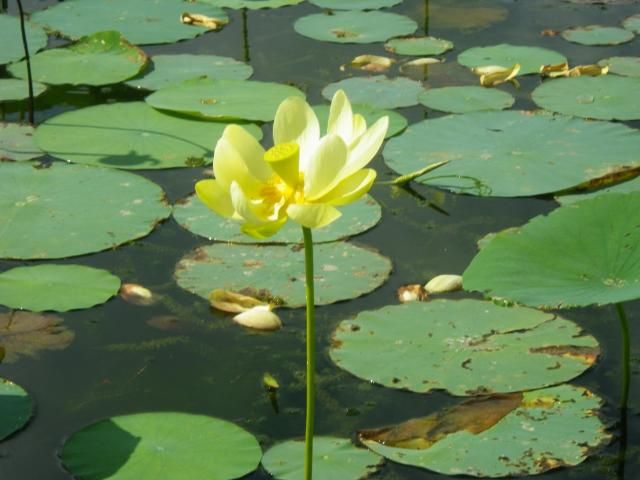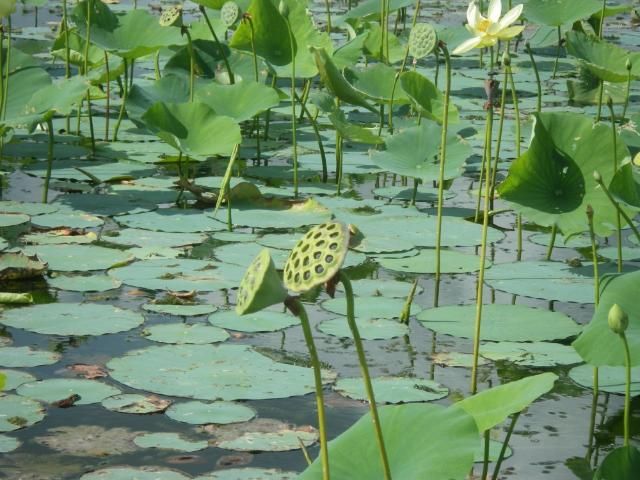Introduction
American lotus is an herbaceous aquatic perennial native plant that tolerates a wide range of conditions (e.g., pH, soil composition, and water depth). In order to thrive, the American lotus requires full sun, loamy soil, and space. The fragrant yellow flowers, huge round leaves, and persistent seed pods borne on stiff stalks high above the water make the American lotus both distinctive and visually striking. This species has long been valued for more than its beauty. For example, Native American tribes treated the American lotus as a sacred plant with mystical powers, and many tribes ate the plant's large rhizomes and used parts of the plant for medicinal purposes. When coupled with its beauty, the plant's ability to flourish in various areas makes it an ideal native plant for constructed or restored wetland areas, where it provides shelter, habitat, and food for wildlife.

Credit: Lyn Gettys, UF/IFAS
General Information
Scientific name: Nelumbo lutea
Pronunciation: Nee-LUM-boe loot-EE-a
Common names: American lotus, yellow lotus, yonkapin, water chinkapin, chinquapin, macoupin, wagipîn
Family: Nelumbonaceae
Plant type: perennial aquatic plant
USDA hardiness zones: 2–11
Planting time for zones 2–9: May–June
Planting time for zones 10 and 11: March–October
Origin: East Coast of North America—from Ontario, Canada, to Florida
Uses: Young and newly unfurling leaves can be prepared like spinach, while seeds can be gathered and eaten like nuts, added as a thickening to soups, roasted like chestnuts, or dried and ground into flour to make bread. In Louisiana, green seed pods are considered a culinary delight; they are harvested during the summer and are eaten as "Cajun peanuts" or "graine à voler." Dried seed pods are used to add interest to flower arrangements.
Availability: Rhizomes and seeds are usually available from aquatic nurseries and can be found on commercial websites as well. However, availability may be limited to spring (February–May).
Description
Plants can grow 1–6 feet (30 cm–2 m) tall with leaves that are up to 40 inches (1 m) wide and simple and round with a rippling margin. Leaves emerge directly from the rhizome and die back during fall. During the summer, American lotus flowers produce large, sweetly scented, and cream to bright yellow flowers. Seeds are borne in pods that resemble a showerhead; the individual round seeds are up to 1.5 inches (4 cm) in diameter. While fresh seeds are firm and green, mature seeds are hard, brown, and persist in the pods after maturity.

Credit: Lyn Gettys, UF/IFAS
Culture
American lotus can be a very strong competitor under the right conditions. This fast-growing species can reportedly expand from six plants that are spaced 10 feet (3.9 m) apart to cover an acre (0.4 ha) in a single growing season. American lotus thrives under submersed conditions and prefers acidic soil, but it tolerates a wide range of soil types. Optimal planting environments are shallow ponds with water about 3 feet (90 cm) deep and with a soil at least 8–12 inches (20–30 cm) deep. When used in mitigation and restoration projects, American lotus should be spaced 36–60 inches (1–1.5 m) apart. Although lotus grows best in full sun and fresh water, the Asian or sacred lotus (N. nucifera), which is its close relative, is a sodium hyper-accumulator that grows in brackish water. American lotus is a very sturdy plant, and its long-term health is usually not affected by pests. However, the seeds of a population in northern Alabama were decimated by the American lotus borer (Ostrinia penitalis) at the peak of seed production, and the red spider mite (Tetranychus tumidus) and the waterlily aphid (Rhopalosiphum nymphaeae) reportedly attack lotus in the United States. In addition, researchers at Auburn University have found infestations of the two-spotted spider mite (Tetranychus urticae) on lotus.

Credit: Lyn Gettys, UF/IFAS
Propagation
Lotus can be propagated via seeds or through division of underground rhizomes. Before germination, seeds must be scratched or nicked to allow water to penetrate through the hard seed coat. Scarified seeds should be submerged in water; seeds that float are not viable and should be discarded. Seeds germinate in as little as 4–5 days if temperatures are kept more than 80 °F (27 °C). Seedlings can be transplanted when they are two weeks old, but they rarely bloom until the following season. Planting enlarged rhizomes produced in the previous year is the best and simplest method to ensure good establishment of new plants in a single season. Rhizomes should have at least two segments sealed at either end by an intact node, and planting should be completed before rhizomes break dormancy. Rhizomes should be planted in saturated media at a 15° angle with the shoot meristem buried 2 inches (5 cm) under the substrate.
Production
Because American lotus is a large plant with the potential to dominate culture systems, the plant can be grown in a container to restrict its growth. Shallow, wide, and round containers with a volume of 15–25 gallons (57–70 L) are more preferable than rectangular or square containers. The growth and flowering are optimized when American lotus is grown in a rich fertile substrate, which is ideally a soft silt loam or clay loam. Substrates with some organic components (such as manure or well-rotted mulches) that improve texture and provide nutrients over an extended period are excellent substrate choices. A mix of pine bark and topsoil also provides a substrate that is lightweight with good texture for lotus culture. Although American lotus grows best in acidic soil (pH 4.5), the Asian species reportedly tolerates substrate pH values that range from 5.5 to 9.0. Containers should be filled at one-quarter to one-half of their depth to ensure good rhizome development and flower production. Mature plants growing in 15-gallon containers should be fertilized every 20 days with 1–2 teaspoons (4–8 g) of a complete (20-10-20) water-soluble fertilizer. Supplemental applications of iron may be used if leaf areas between the veins become yellow and nitrogen has already been applied.
Cultivars and Selections
Although very few unique forms of American lotus have been found, there are specimens with small differences in color (from deep yellow to white cream) and leaf and seed pod size, as well as the presence or absence of thorns on petioles. Many known variants of sacred lotus have been described, including red, pink, yellow, white, and bicolor types with single, double, or multi-petal blooms, but only one variant (a natural mutation known as 'Yellow Bird') of American lotus has been identified. Hybrids from crosses between American and sacred lotus (N. lutea × N. nucifera) are readily available through the water garden market and include 'Louise Slocum,' 'Mrs. Perry D. Slocum,' 'Patricia Garrett,' 'Perry's Giant Sunburst,' 'Strawberry Blonde,' and, most recently, 'Kenny's Dream.'